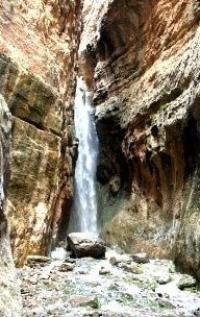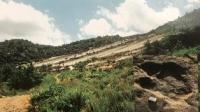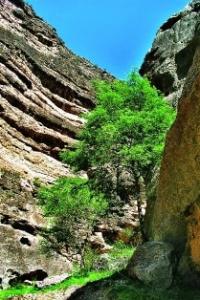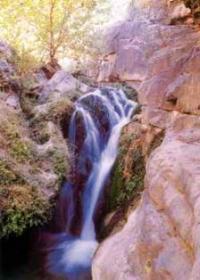You are here
Tourist sights of Kugitangtau.




Travel to Kugitangtau.
“What made both man and animal strive for these barren heights? Dr. James Chapin, who has devoted many years to studying the birds of the Congo, once found the skeleton of a Gamlin monkey on the top of Karisimbi, many miles from its native forests. And recently I read an interesting article about a pack of hyena dogs that was seen in the Kilimanjaro glaciers, at an altitude of almost twenty thousand feet. Perhaps a person is not the only creature in this world who climbs a mountain just because it is in front of him"
George Schaller. "Year under the sign of the gorilla." M., Thought, 1968.
Photo tours in Kugitangtau mountains.
Here are the highest mountains in Turkmenistan, the deepest lakes, the longest and most unusual caves, the most majestic natural waterfall in the country. There are healing hydrogen sulphide springs and the largest grove of rare unabi trees in Central Asia, which disinfect the surrounding area.
And here you can also walk along the bridge of time, one and a half hundred million years long and touch eternity - fossilized dinosaur footprints, of which there are more preserved in these places than anywhere else in the world.
The name of this amazing land in the south-east of the republic is Koytendag, which means "Mountains of deep canyons". To preserve the extraordinary beauty of these places, which deservedly have the status of natural monuments, the Koytendag State Reserve was created.
People from all over Turkmenistan and other countries come here in search of exotic experiences. In the future, a national nature park will be created in the Koytendag mountains on the basis of the reserve. Preparatory work is already underway, the Ministry of Nature Protection is developing tourist routes.
Guests of Koytendag are surprised at once: its foothills are already unusual, painted in red tones of different shades. Soils acquire such an unusual appearance due to the emergence of variegated rocks. If you go higher, Koytendag will lay a soft carpet of golden grasses from the sun under your feet.
Even higher, it becomes golden green. And then completely saturated emerald, moreover, decorated with many flowers - heavenly blue with miniature bells of medicinal gentian, yellow anemone stars, pale pink primroses. A true extravaganza of light and colors!
Far away, at the very horizon, the Amu Darya can be seen, but from here, tens of kilometers away, the mighty river looks like just a silvery ribbon. Closer is the vast Magdanla Highlands. And along the surrounding slopes, there is a light forest of juniper - juniper.
These trees do not differ much from their counterparts in the Kopetdag; they are also dressed in a magnificent robe of green needles all year round. They are tall and slender, however, where the wind is stronger, powerful juniper trunks spread along the ground, bizarrely curved, as if according to the idea of an avant-garde artist.
At the mountain peaks, juniper forests give way to the fragile, but, it turns out, even more hardy honeysuckle. The stone placers are adorned with funny thorny pillow plants and delicate saffron-crocus inflorescences, which in spite of everything open up among the snow and ice towards the sun's rays.
And the peaks themselves are wrapped in a thick snow blanket for six months, if not longer. The sparkling regal mantle flaunts on Koytendag almost until hot summer days, reluctantly succumbing to the energetic Turkmen sun.
It is here, shining with a snow-white dress in a frame of beautiful forests, majestically, at 3139 meters above sea level, the highest mountain peak of the country rises - Beyik Turkmenbashi peak. Even when it melts, the snow does not disappear without a trace.
Melted water feeds numerous springs, thanks to which Koytendag remains a green island surrounded by arid plains. The contrast is especially noticeable in the narrow long gorges "dere" cut into the mountains, where cool springs flow among thickets of fragrant mountain mint and transparent streams murmur melodiously.
It happens that mudflows rumble here, rolling the sharp edges of large boulders into rounded pebbles and making the gorges even deeper and more severe. Each gorge is unique in its own way. So, in Bulak-dera, on the cornice of the rock at the exit of the ground waters, from where the waterfall breaks down, once grew a moisture-loving maidenhair fern - Venus hair.
And now the cornice is decorated with "strands" of the goddess of love, through which crystal drops flow, and the waterfall itself is called "Hair of Venus". In the Khoja-Karaul-dere gorge, guests are greeted by an almost 800-year-old mulberry tree "Kyzyl-tut-baba", decorated with many colorful patches tied to fulfill the most cherished desires of travelers who have been here.
The pearl of Umbar-dere is a waterfall of the same name, 27 meters high. You have to walk to it for a long time along a stone corridor with high steep walls, so narrow that the sky above your head can be seen only as a thin strip, and any sound echoes with a booming echo.
The waterfall is very beautiful - the water stream crashes down with noise, and thousands of splashes form a magnificent water curtain, trimmed with the finest muslin of the smallest drops. The Darai-dere gorge is the widest and longest gorge, 30 kilometers long.
Rugged thickets of the Caucasian carcass, fluffy maple, wild rose, wild grapes provide a safe haven for many protected inhabitants. In Koytendag live mountain sheep, Turkestan lynx and other animals listed in the International Red Book. Only mammals on the territory of the reserve are four dozen species.
The markhor goat stands out among them. Markhor means "devouring serpent" - so the legend says, but his diet does not differ much from the addictions of other ungulates. The appearance of the markhor is peculiar - the heads of the males are crowned with unusual, spirally twisted horns.
These animals are ideally adapted for life among stone cliffs, their every movement is verified and precise. Otherwise it is impossible: one wrong step - and the markhor will fall into a deep abyss, because his favorite habitats are high in the mountains, on rocky ledges and stone shelves.
Among the birds, the most representative are predatory ones - the hawk, steppe eagle, long-legged buzzard. The birds with a more peaceful disposition are also interesting, including such rare ones as the Brahmin starling and the unusually attractive paradise flycatcher.
More than two and a half dozen species of reptiles can be found in tall grass and among stone placers. These are poisonous cobra and gyurza, as well as a frightening-looking, but harmless, eared round-head. Lucky, you will see the largest of the lizards - the monitor lizard.
But, perhaps, the most unusual inhabitant of these places is the Koytendag blind loach, a miniature fish devoid of eyes and scaly cover. This is a pronounced example of the quirks of evolution. Most likely, once the population of the ancestors of this fish accidentally fell into the vast network of underground reservoirs of the region with a developed karst process.
Vision in complete darkness is not needed, so rational nature has deprived the char of the opportunity to see. Perhaps people would never have known about the wonderful fish if it were not for the karst hole with a lake located in the vicinity of the village of Karlyuk, the waters of which are connected with the underground.
This is where the blind loach appears, included in the Red Book of Turkmenistan. The flora of Koytendag is also peculiar - tall, laced foliage frames, huge mulberry trees in the gorges, century-old plane trees. The hollow plane trees "Uchdogan" can easily accommodate a dozen people.
And the unabi grove has about 2,000 trees and is revered by the local population as a holy place. Unabi (also called the Chinese date or ziziphus) has been famous for its medicinal properties for a long time. Legend has it that once a venerable traveler stopped here to rest.
Saddened that there was little greenery around and no shade, the elder struck the stony ground with his staff. And a crystal spring gushed out of the ground, a wonderful garden appeared, the first unabi tree in which this magic staff became.
The mealy fruits of this rare tree species have been used since ancient times against diseases of the heart, kidneys, liver, and stomach. The Koytendag mountains are a southwestern spur of the Gissar ridge, the western (Turkmen) slope of which is composed of Upper Jurassic limestones. Many karst caves have been discovered here.
Others are many kilometers long, they are real underground labyrinths, beautiful and mysterious. Water, drop by drop, carrying dissolved limestone, like a skilled designer, tirelessly renews the decor of the caves.
It takes many years for the stone icicles decorating the vaults of the dungeons - stalactites and stalagmites rising to meet them - to grow up by a few centimeters. In the end, they grow together into columns of stalagnates (stalacton).
This splendor has been created for more than one thousand years, it is very vulnerable and needs to be treated with care. On the territory of the Karlyuk reserve there are several famous caves, including including Cap-Coutin - one of the most beautiful and longest in Koytendag.
“It happened that scientists-speleologists explored the rich decoration of the cave and its labyrinths, without leaving the surface for several days or even weeks,” says the inspector of the reserve Erkin Aralov. Indeed, not far from the entrance, the beams of the lanterns snatch from the pitch darkness cascades of water-filled stone bowls - karr, separated by graceful bridges.
We, like obedient schoolchildren in an exemplary museum, turn our heads, trying to better see all the "exhibits". And there is something to see. In one of the "halls" a kind of jellyfish is spread out on the wall. You will not immediately guess that this is actually a huge, bizarre stalactite.
There is also the "Hall of Santa Claus", named so because of two unusual stalagmites. You don't need to have a special imagination to guess the outlines of Santa Claus and his granddaughter Snegurochka in the stone statues.
The "Gothic Hall" is decorated with openwork, as if in a cathedral, colonnades, whimsical stone flowers, draperies and "pools" filled with water. The luxury of the decoration can only be compared to the "Pearl Hall", the floor and walls of which are richly inlaid with formations of calcite, reminiscent of pearls.
The labyrinths are intricate, there are many manholes and narrow passages. Only from the "Main Hall" of the cave can be counted a dozen exits - without a knowledgeable guide you will not find what you need. But continue to be prepared for the unexpected.
In one of the "halls" a monster lurked, in fact, it turns out to be a huge block. It seems alive and flaunting on the ceiling of one of the underground galleries "stone heart" - a bizarre stalactite shape. The Koytendag dungeon system is very complex.
Scientists believe that underground passages and streams connect into an intricate network not only caves, but also karst holes and lakes. One of the most amazing is Lake Kattakol, 59 meters deep. Let it be extremely rare, once a decade, but absolutely unusual events happen here: suddenly a seething whirlpool appears, which can absorb much more than a third of the volume of the reservoir.
However, then the Cattacol is sure to be refilled again. Unusual phenomena are observed in other places as well. So, the surface of Lake Khorzhun is usually calm, like in an aquarium, and the water is clear. But it happens that in rainy years in the spring, mud rises from the bottom of the karst underground, leaves and objects that have clearly fallen there from the surface emerge.
But where exactly is a mystery. The place of Kainar Baba is very interesting. There are two sources here - Karasu and Aksu. The first feeds a small picturesque lake in an emerald rim of reed thickets, inhabited by many carps, rare mollusks.
According to legend, this place was the abode of a righteous old man, it is revered among the people, and no one catches fish here. The healing hydrogen sulphide spring Aksu is also famous among people. The water in it is saturated with many bubbles, as if boiling, and the very word "kainar" means "boiling."
The famous Dinosaur Plateau is located in the Khojapil reserve of the reserve. Khojapil can be translated as “The elephants of the saint”. It was believed that many huge, unusual-shaped footprints that dot the rocky plateau were left by the fabulous elephants of the wandering hajji, who returned from India with strange animals, in ancient times.
They were also associated with elephants in the army of Alexander the Great. However, over time, researchers have established that the paw prints belong to huge, long-extinct reptiles that roamed the seashore in shallow waters in the Upper Jurassic era 150 million years ago, when there were no mountains here yet.
Then the sea retreated, the traces on the soft limestones were petrified, were buried under a layer of sediments, and when the powerful process of mountain building began and the Koytendag rose, they were carried by underground forces to the surface.
Over the years, it is difficult to understand why dinosaurs once fell in love with these places, but they left 2500 traces that have survived to our era. They belong to three previously unknown genera of ancient two-legged dinosaurs called Turkmenosaurus, Hodjapilzaurus, and Hisarosaurus.
All of them were herbivorous, Turkmenosaurus and Hodjapilzaurus were three-toed, Hisarosaurus were four-toed. The largest of them is the Turkmenzaurus. The size of his footprint reaches 70 x 65 centimeters. Most likely, their length was up to 20 meters, and they moved with the help of powerful hind limbs.
The front ones were much shorter; the lizards did not use them when walking. Another local attraction is the Palvana stone. Palvan in Turkmenistan is called a man of unprecedented strength, who has no equal in wrestling competitions.
And the Khojapil hero, according to legend, was unusually strong, so more than once the daredevils, those who dared to challenge him died in an unequal battle. Therefore, Palvan threw a large stone near the road to the village, so that everyone who wanted to measure his strength with him, first proved his worth by lifting a huge boulder.
And if it didn’t work, then I wouldn’t risk it in vain. Now a large stone, which our contemporaries cannot even move, reminds of the heroes who once lived here. The gloomy grotto "Kyrkgyz" or "Forty girls" is also fanned by legends.
As the ancient legend says, here in ancient times 40 beautiful beauties hid from the ruthless enemies, until they managed to find out the secret of the grotto. Then the girls asked God to turn them into stones so as not to get the evil enemy.
Since then, "Kyrkgyz" has been revered among the people. Arriving here, they make a wish and, having dipped the ribbons in advance in wet clay, throw them to the vault of the grotto. It is believed that if a strip of fabric sticks to the stone ceiling, the wish will certainly come true.
Many thousands of fancy fringed ribbons hang from the vaults of the grotto, reminding of fulfilled desires. Indeed, having visited Koytendag, it is hard not to believe that magic is possible. The nature is so amazing and bright here, so many memorable meetings are prepared for the inquisitive traveler "The Land of Deep Canyons".
And throwing a ribbon to the vaults of the "Kyrkgyz" grotto, the guests of Koytendag wish to return here more than once.
Geographic coordinates of the Kugitangtau mountains: N37 ° 46'56.67 "E66 ° 33'05.77"
Authority:
Oleg Vinokurov. Photo by Khasan Magadov.







